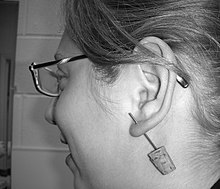Receiving tube
A Receiving Tube (from english to receive received = and Tube = Tube) is a protective tube when piercing is used to generate by piercing the be pierced skin area a back pressure and not to injure the surrounding connective tissue to hard to reach areas.
It is a tube usually made of stainless steel with a length of about ten centimeters and a diameter between five to ten millimeters and has either straight (flared receiving tube) or beveled ends (angled receiving tube). Disposable tubes made of PTFE are also increasingly being used.
history
Originally, corks were often used to achieve better stability when piercing an ear hole , for example , and to avoid further injuries. With the advent of modern piercing, jewelry also became popular in unusual places where the use of corks was hardly possible due to the anatomical nature. In addition, a cork usually does not meet the hygienic requirements compared to a tool made of sterilizable steel.
application
A receiving tube is used for parts of the body where the anatomical conditions could lead to injuries to parts of the body that are close to each other or adjacent, for example with the Nostril piercing , the daith , the inner conch piercing , the vertical clitoral hood piercing or the Prince Albert . Receiving tubes are often used on various parts of the body as an alternative to piercing clamps , for example a flared receiving tube instead of a septum clamp. It is held on the opposite side of the body part to be pierced so that the needle, after it has been pierced through the skin, slide into the tube or can be caught by it and does not pierce the surrounding tissue again.

